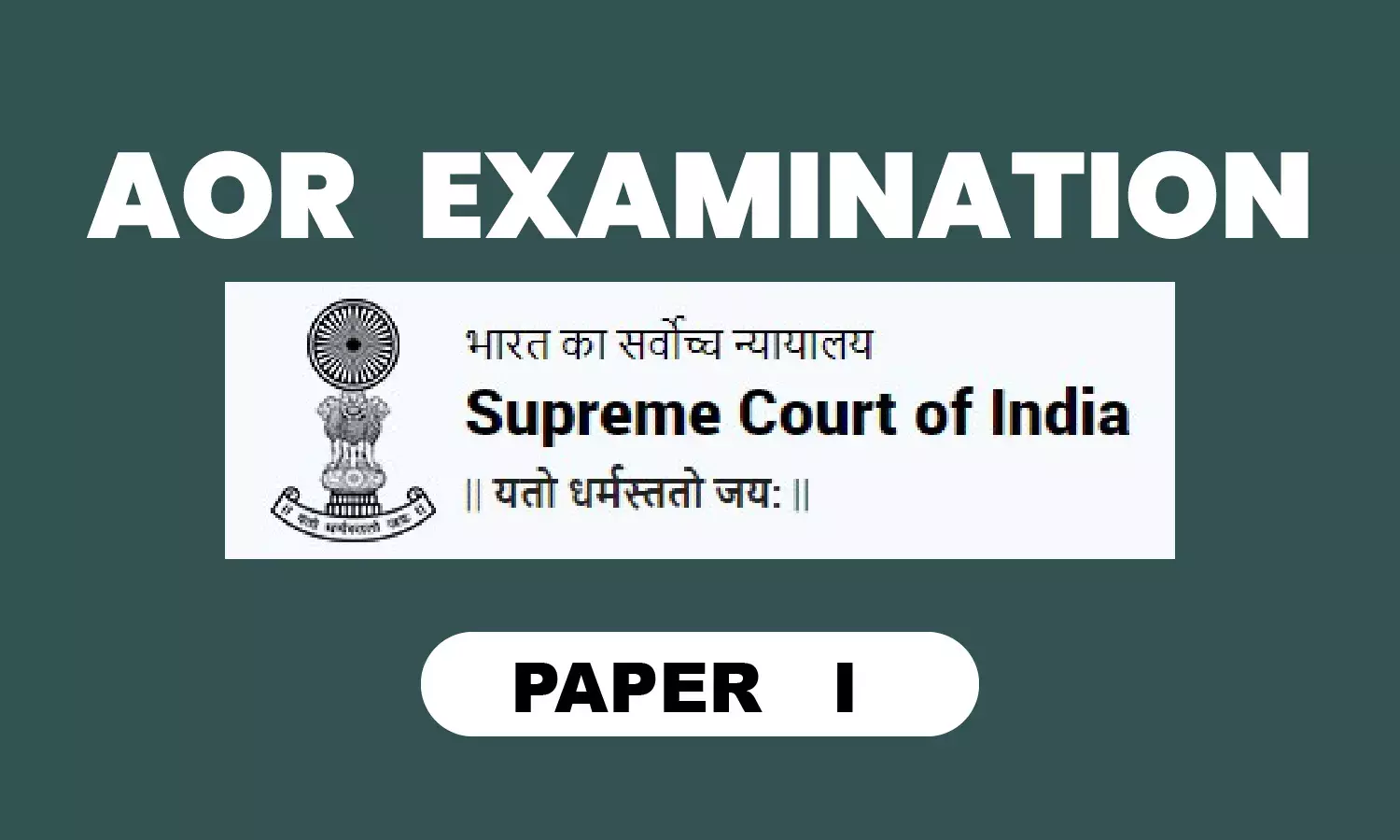Topper’s Answer Script, Sample Handwritten Notes And Guide Points On Paper-I ‘Practice And Procedure Of Supreme Court’ Before Attempting The Advocates-On-Record Examination, 2024
The disclosure of my certified answer script for Paper IV ‘Leading Cases’ in the previous write-up is expected to benefit the candidates in some manner, at least, in the manner of writing answers in this examination, and with that in mind, I now turn to Paper-I ‘Practice & Procedure of Supreme Court’, in the same sequence which I myself followed during the last attempt, having remained conscious of the fact that it being largely codified, would involve the understanding as well as retaining the content, specifically, the Articles of the Constitution, Orders and Rules of the Supreme Court Rules, 2013 and ratios of the relevant case laws. The following material consisting of my certified answer script, sample handwritten notes as well as guide points are most likely to aid in the preparation of the current examination.
Lectures by Ld. Senior Advocates organized by the Hon’ble Supreme Court of India.
The Lecture, as delivered by the learned senior advocates, is undoubtedly essential as it underscores the important areas upon which one should primarily keep his or her focus, and like previous attempt, Ms. Vibha Datta Makhija, Ld. Senior Advocate, (watch here) shared a Power-Point Presentation (PPT) dealing with few areas from the Constitution as well as the Supreme Court Rules, 2013, which are to be strictly prepared without fail, though guarantee is no man’s land here. Although, unlike previous attempt, wherein detailed description of the topics were provided and so proved to have enabled one with a better preparation strategy, the following inputs are gathered this time:
- The concentration should be on Supreme Court Rules, 2013 along with Handbook on Practice and Procedure and Office Procedure, 2017, as released by the Hon’ble Supreme Court of India.
- The answers should be ‘to the point’, and essentially, in brief.
- The answers should be point-wise correlating with the sub-parts of the questions, so as to be found convenient both to the candidate, while answering, as well as to the examiner, while evaluating.
- The answers should reflect the practical approach i.e. how things happen in actual in the Hon’ble Court and Registry.
- The answers must necessarily have three (3) parts, one, the substantive statutory or constitutional provision, second, the practice or procedure pertaining thereto, and third, the ratio of the case laws relevant to the issue(s) in question.
- The suggestive topics include Article 32 ‘Writs’, Public Interest Litigation, Contempt Jurisdiction, Transfer Jurisdiction, Appellate Jurisdiction, Article 134(2) along with Supreme Court (Enlargement of Criminal Appellate Jurisdiction) Act, 1970 and Order XX of SC Rules, 2013, Article 131 ‘Original Jurisdiction’, Article 141 ‘Law of Precedent’, Article 142 ‘Power to do Complete Justice’, Article 143 ‘Advisory Jurisdiction’, Article 137 ‘Review Jurisdiction’, Curative Petition, Statutory Appeals (under Customs Act, 1962, Consumer Protection Act, 2019, Contempt of Courts Act, 1971, TRAI Act, 1997 and others) and Professional Misconduct under Section 35 of the Advocates Act, 1961.
- The candidates are expected to memorize the Orders’ and Rules’ number correctly.
Analysis of Past Years’ Question Papers of Advocates-on-Record Examination.
The analysis of past years’ question papers was not attempted to be done for this paper, primarily on account of it having an element of fundamental knowledge component pertaining to practice at the Hon’ble Supreme Court of India, and therefore, required to be studied in whole, but for candidates, who are short of time, due to any reason(s) whatsoever, may do so as to find out the questions repeated over the years. However, one should not shy away from having a glance through the past years’ question papers so as to prepare his or her mind about the larger structure or pattern of the examination, as this paper essentially focusses more on sub-parts based short questions, which require correct ‘to the point’ answers, unlike detailed descriptive type questions, besides objective questions which are truly scoring without any hassles.
Perusal of Topper’s Answer Script in correlation with the Last Year Question Paper.
The perusal of the topper’s answer script when studied along with each question asked would bring the importance of following points of general consideration:
- Time-based content management i.e. the words’ limit up to which an answer be written commensurate with the value of marks ascribed to it.
- Margins being drawn on each page.
- Short points/paragraphs.
- Own language with element of legalese.
- Sub-parts of answers necessarily from next page.
- Headings and Underlining Key Phrases/Words/Lines.
- Basic Clear Handwriting with Minimal Errors.
At this juncture, where the examination is so close, the intent is not to provide additional material for preparation, but a guiding direction to be captured, adopted and implemented during the examination without much effort. However, considering the present paper, certain topics which were not discussed during the lecture viz. Judicial Review, Order V – Registrar/Chamber Judge, Order XI Rule 6 – Vacation Judge, Order IV – AORs, Order VI – Single Judge, Order XI – Notice of Motion, XLVI – Election Petition, Table of Fees, Single Bench, Division Bench, Constitution Bench and Reference to Larger Bench, Per Incuriam, Ratio Decidendi versus Obiter Dicta, Sub-Silentio, Doctrine of Eclipse, Colourable Legislation, Order XXXVIII, How a midnight hearing can be sought before the Supreme Court?, Legal Aid, Recusal of Judge, Master of Roster, Locus Standi, How early hearing of a regular matter be sought?, In what manner, can new and old matters be heard by vacation judge?, List of Urgent Matters, Interlocutory Order versus Interim Order, Under what circumstances, an AOR can be removed from the register of AORs?, List of Relevant Case Laws with brief ratios, E-Filing Procedure, Impleadment versus Intervention, cannot be afforded to be left out, if not already taken up. It may not be surprising if real life case scenario based on practical procedure or practice being followed at the Hon’ble Court, whether pertaining to a topic like mentioning or like, is asked, and therefore, expressing one’s view at the end of each answer is likely to garner an overall not less than a ten (10) per cent rise in aggregate marks, which may prove to be the savior to pass for those who are finding the paper difficult as such for now. The need to adduce latest or other judgements may be considered an individual choice, and should only be explored if one knows about it. The paper is generally composed of a strategic mixture of subjective as well as objective questions, making it easier to be happily completed within the deadline of three (3) hours. The paper holds importance for the examination as it has the tremendous potential, if exploited, to make up the aggregate, considering the experience of difficulties faced as shared by the candidates in attempting as well as passing the Paper-II ‘Drafting’, as it proved to be in my case, when I was able to secure ninety-eight (98) marks in this paper, setting out a good momentum for other papers to follow. The candidates may very well keep the days i.e., 08th and 09th June, earmarked for preparation for the first paper, as a good start will boost the confidence to tackle the paper of ‘Drafting’ next.
Click here to read/download Author's sample handwritten note
Click here to read/download Author's answer paper
Author is a practicing Advocate-on-Record at the Supreme Court of India, a practicing Advocate and a non-practicing Chartered Accountant. He secured 2nd rank in the Advocates-on-Record Examination in 2023.
[The opinions expressed in this article are those of the author. Verdictum does not assume any responsibility or liability for the contents of the article.]













